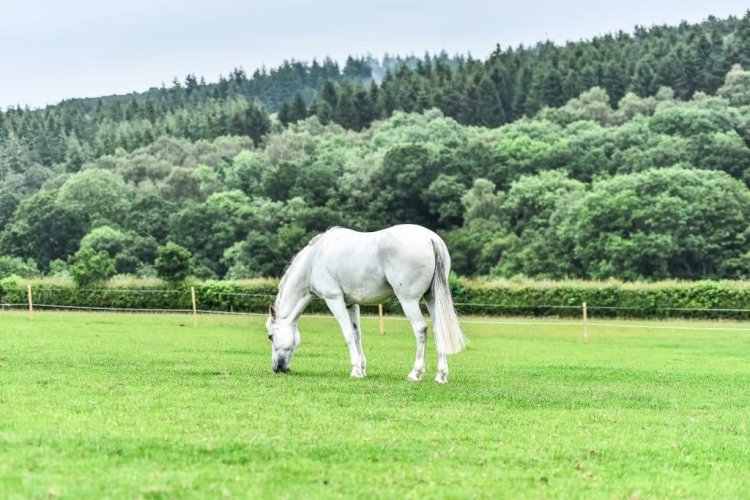in basket
TOP OFFER - SPRING20 - 20% OFF and 4 FREE seasonal products!
Understanding your horse's pasture

Introduction
In cold and temperate climates, such as the UK, most grasses in your pasture are cool-season grasses. These types of grasses grow rapidly in the spring, when soil temperatures reach 4-6oC, and less in the summer months as conditions are much dryer followed by another growth spurt in the autumn. During the winter months there is little to no growth even though they may remain green. In terms of the types of plant species present in the pasture, this depends on whether the pasture is what we call natural (or unimproved), which refers to those pastures that have not been specifically sown for grazing animals. In natural pastures, there will be a much more diverse range of plant species; a variety of grasses, heathers, rushes and mosses. Improved (or cultivated) pastures refer to those that have been specifically sown for grazing or forage conservation and have a less diverse array of plant species. Improved pastures often contain plant species that are of higher nutritional value; for example, ryegrasses, cocksfoot, fescues, and legumes such as white clover.
Grass growth
Grass needs energy to grow and it obtains this energy from sugars (also known as saccharides) that it produces via photosynthesis. Photosynthesis is a process whereby plants convert light into simple sugars. Simple sugars are essentially single sugar molecules (also known as monosaccharides); for example, glucose and fructose are simple sugars. During daylight hours, grass photosynthesises simple sugars and these simple sugars are essential for grass growth.
The plant then takes these simple sugars and converts them to more complex sugars. These more complex sugars are known as structural carbohydrates and because they consist of chains of many sugars they are known as polysaccharides.
Plant constituents
It’s important to understand carbohydrates (CHOs) in horse diets, because how we refer to CHO in horse diets is different to how we think of them in our own diet. In humans, we often talk about a low CHO (or low carb) diet. This refers to a low soluble CHO diet. Soluble carbohydrates include simple sugars, starch and fructan. Starch is a polysaccharide that is made up of many glucose sugars, whereas fructan is made up of the simple sugar fructose. In human diets, when we talk about CHO we are usually referring to starch. However, starch, fructan and simple sugars are collectively known as non-structural CHOs, while there are other CHOs that fall under the category of structural CHOs. Structural CHOs are also referred to as fibre or the fibrous fraction of the plant. Plant cells are different to animal cells in that they have a cell wall (See Figure 1 below), which is needed to provide rigidity and protection to the plant without preventing the diffusion of nutrients (including water) into the plant cell.

Figure 1: A simplified diagram of a plant cell.
As the plant grows the ratio of the cell wall to the cell contents increases, which means the cell wall increases in size and the cell contents decreases. The plant cell wall is predominantly composed of structural CHO and it is those CHOs that horses primarily derive their energy from. Structural CHOs are divided into three classes, cellulose, hemicellulose and pectin. You may recall from my previous articles that the horse’s hindgut contains microbes that degrade fibre to produce volatile fatty acids, which is used as the main energy source by the horse.
Lignin is a compound you may have heard of. It is important to point out that lignin is not a CHO, but it is closely associated with them. As the plant grows, the amount of structural CHOs present increases along with lignin. Lignin provides structural strength to the plant and is therefore present in higher amounts in the plant stem. Lignin is almost completely indigestible and because it entwines itself around the structural CHOs it can reduce the digestibility of them by preventing the microbes in the hindgut from accessing the cellulose, hemicellulose and pectin. This is why more mature forages, such as grass hay, which has a greater proportion of stem compared to younger pasture, is less digestible than immature grass in pastures.
Having talked about structural CHOs, it’s also important to understand the non-structural CHOs (NSC) present in pasture. NSCs are those carbohydrates that are present in the cell contents (in the chloroplasts within the cell) and in temperate grasses these are predominantly simple sugars and fructans. Collectively, simple sugars and fructan are referred to as water soluble carbohydrates (WSC). You may recall from previous articles that horses lack the enzymes in their small intestine to digest fructan and consequently fructan travels to the hindgut where it is fermented by the microbes. In a similar way we want to avoid high amounts of starch reaching the hindgut, it is the same for fructan. The main difference here though is that starch can be digested in the foregut and we can implement feeding management strategies to maximise this small intestinal digestibility of starch. Conversely, we cannot do this with fructan, which is why we need to ensure we manage our pastures and turnout effectively and I’ll be discussing pasture management in my next article.

Figure 2: Grass components through the stages of growth.
Grass pasture also contains protein, a small amount of lipid (oil), vitamins and minerals. The mineral content of pasture plants is variable and depends on several factors such as plant species, soil type, stage of growth, fertiliser usage etc. In terms of vitamins, as a rule of thumb most green forage crops are an excellent source of the vitamin A precursor b-carotene, vitamin D precursor ergosterol, vitamin E and many of the B vitamins. Figure 2 below shows how the composition of grass changes as it grows.
Nutritional composition of pasture
The nutritional composition of pasture is highly variable and dependent on plant species present, management and the environment. Light, temperature and nutrients all affect grass growth. For example, the protein content of pasture can range from as little as 3% in mature forage to 30% in young, well fertilised pastures. The fibre content of the pasture is related to stage of growth as discussed above, with mature pastures containing higher amounts of fibre compared to young, leafy pasture. The amount of water in fresh pasture ranges between 75 and 85%, although this is also affected by the weather at the time.

Figure 3: WSC content of pasture at different months of the year
(Longland, 2007).
The WSC content of pastures is incredibly variable, not just on a daily basis, but on an hourly basis – depending on the weather. The WSC content of pasture can range from 5 to 40% and is weather dependant. The type of plant species present in pastures also affects the WSC content; for example, grasses can contain high levels of WSC whereas legumes (e.g. clover) contain only very small amounts of starch as their storage CHO. You can see from Figure 2 above that stage of growth has a huge impact on the amount of NSC present in grasses, with more mature pastures containing higher levels, which is why mature grass hay can contain high levels of WSC, contrary to what many owners perceive. The stem of the plant also contains more WSC than the leaf, and again is why more mature grasses contain higher WSC levels. Time of year (season) has a major impact on WSC levels, along with the environment. The graph below shows that, generally, WSC contents tend to be lower in early spring, higher in May, but may also be present in substantial amounts in August before dropping back around October time. However, it is important to recognise that this is highly variable and substantiates the need for our understanding of how the environment impacts on pasture WSC levels.
Essentially, the WSC levels in pasture are a result of the balance between photosynthetic activity (i.e. the amount of WSC produced) with the amount used by the plant. This is affected by light, temperature and nutrients. For example, if it is bright and warm then the grass will make WSC and use it to grow. Conversely, if it is bright and cold then the grass will produce WSC, but not use it and therefore the WSC is stored in the plant. Water is also required for growth and therefore if it is bright and warm, but little water (rainfall) then the plant cannot grow thus WSC is stored. In fact, WSC levels change throughout the day, with lower levels present in pasture overnight and higher during the day, usually peaking around mid to late afternoon (see Figure 4). However, again this is highly variable and depends on the weather that day.
In summary, the nutritional composition of pasture is highly variable and whilst we can analyse conserved forage for their nutritional values to enable us to balance our horse’s diets, it is impossible to do this with pasture because of the dynamic nature of it and how its composition changes on an hourly, never mind daily, basis. Having said that, what we can do is use our knowledge of how the environment can impact on pasture to inform how we implement pasture and animal management strategies.

Figure 4: WSC content of pasture throughout the day (Longland, 2007).
Article written for Premier Performance by Professor Jo-Anne Murray.






